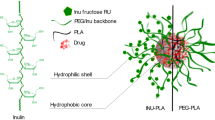Abstract
Novel amphiphilic copolymers on the basis of 2-oxazolines containing a free amino group were prepared. The copolymers were synthesized by the living cationic polymerization of 2-ethyl-2-oxazoline (ETOX) and 2-(4-aminophenyl)-2-oxazoline (APOX). The main goal of this work was the synthesis of water soluble polymer material with the defined number of functional groups necessary for the attachment of proteins and polysaccharides. A high concentration of free amino groups allows immobilization of various biosubstances, e.g. drugs, proteins or polysaccharides. Thermal properties have been studied with respect to the composition of the copolymers. Cytotoxicity and the bioimmunological efficiency of the selected copolymer were studied.







Similar content being viewed by others
References
Adams N, Schubert US. Poly(2-oxazolines) in biological and biomedical application contexts. Adv Drug Deliv Rev. 2007;59:1504–20.
Aoi K, Okada M. Polymerization of oxazolines. Prog Polym Sci. 1996;21:151–208.
Litt MH, Hsieh BR, Krieger IM, Chen TT, Lu HL. Low surface energy polymers and surface-active block polymers: II. Rigid microporous foams by emulsion polymerization. J Colloid Interface Sci. 1987;115:312–29.
Weberskirch R, Hettich R, Nuyken O, Schmaljohann D, Voit B. Synthesis of new amphiphilic star polymers derived from a hyperbranched macroinitiator by the cationic ‘grafting from’ method. Macromol Chem Phys. 1999;200:863–73.
Gross A, Maier G, Nuyken O. Synthesis and copolymerization of macromonomers based on 2-nonyl- and 2-phenyl-2-oxazoline. Macromol Chem Phys. 1996;197:2811–26.
Hoogenboom R, Thijs HML, Fijten MWM, Van Lankvelt BM, Schubert US. One-pot synthesis of 2-phenyl-2-oxazoline-containing quasi-diblock copoly(2-oxazoline)s under microwave irradiation. J Polym Sci A: Polym Chem. 2007;45:416–22.
Wang CH, Fan KR, Hsiue GH. Enzymatic degradation of PLLA-PEOz-PLLA triblock copolymers. Biomaterials. 2005;26:2803–11.
Uyama H, Kobayashi S. Synthesis of poly(2-oxazoline) macromonomers having a vinyl ester group. Macromolecules. 1991;24:614–5.
Cesana S, Auernheimer J, Jordan R, Kessler H, Nuyken O. First poly(2-oxazoline)s with pendant amino groups. Macromol Chem Phys. 2006;207:183–92.
Zarka MT, Nuyken O, Weberskirch R. Amphiphilic polymer supports for the assymetric hydrogenation of amino acid precursors in water. Chem Eur J. 2003;9:3228–34.
Cesana S, Kurek A, Baur MA, Auernheimer J, Nuyken O. Polymer-bound thiol groups on poly(2-oxazoline)s. Macromol Rapid Commun. 2007;28:608–15.
Taubmann C, Luxenhofer R, Cesana S, Jordan R. First aldehyde-functionalized poly(2-oxazoline)s for chemiselective ligation. Macromol Biosci. 2005;5:603–12.
Nuyken O, Maier G, Gross A. Systematic investigation on the reactivity of oxazolinium salts. Macromol Chem Phys. 1996;197:83–95.
Culbertson BM, Xue YP. Synthesis of 2-(p-aminophenyl)-2-oxazoline and its cationic polymerization studies by differential scanning calorimetry. J Macromol Sci: Pure Appl Chem. 1997;A34:1737–46.
Rihova B. Biocompatibility of biomaterials: hemocompatibility, immunocompatibility and biocompatibility of solid polymeric materials and soluble targetable polymeric carriers. Adv Drug Deliv Rev. 1996;21:157–76.
Stuart LM, Ezekowitz RAB. Phagocytosis: elegant complexity. Immunity. 2005;22:539–50.
Gordon S. The macrophage-past, present and future. Eur J Immunol. 2007;37:S9–17.
Midwood KS, Williams LV, Schwarzbauer JE. Tissue repair and the dynamics of the extracellular matrix. Int J Biochem Cell Biol. 2004;36:1031–7.
Felix K, Lin S, Bornkamm GW, Janz S. Tetravinyl-tetramethylcyclo-tetrasiloxane (tetravinyl D4) is a mutagen in Rat2 lambda lacl fibroblasts. Carcinogenesis. 1998;19:315–20.
Mosmann T. Rapid colorimetric assay for cellular growth and survival: application to proliferation and cytotoxicity assays. J Immunol Meth. 1983;65:55–63.
Leffler M, Adams T. Aminophenyl-2-oxazolines as local anesthetics. J Am Chem Soc. 1937;59:2252–8.
Sashidhar RB, Capoor AK, Ramana D. Quantitation of epsilon-amino group using amino-acids as reference-standards by trinitrobenzene sulfonic-acid—a simple spectrophotometric method for the estimation of hapten to carrier protein ratio. J Immunolog Meth. 1994;167:121–7.
Farkaš P, Korcová J, Kronek J, Bystrický S. Preparation of synthetic polyoxazoline based carrier and Vibrio cholerae O-specific polysaccharide conjugate vaccine. Eur J Med Chem. doi:10.1016/j.ejmech.2009.11.002.
Costa ED, Pereira MM, Mansur HS. Properties and biocompatibility of chitosan films modified by blending with PVA and chemically crosslinked. J Mater Sci Mater Med. 2009;20:553–61.
Jeong JH, Song SH, Lim DW, Lee H, Park TG. DNA transfection using linear poly(ethylenimine) prepared by controlled acid hydrolysis of poly(2-ethyl-2-oxazoline). J Control Release. 2001;73:391–9.
Janeway CA. Approaching the asymptote? Evolution and revolution in immunology. Cold Spring Harb Symp Quant Biol. 1989;54:1–13.
Splettstoesser WD, Schuff-Werner P. Oxidative stress in phagocytes-“The enemy within”. Microsc Res Tech. 2002;57:441–55.
Acknowledgements
This work was supported by Project No. 2/0157/09 from the Slovak Scientific Grant Agency and Project No. 003206 from the Slovak Research and Development Agency. The authors thank Dr. I. Lacik for providing the molecular characteristics of the synthesized polymers and copolymers.
Author information
Authors and Affiliations
Corresponding author
Rights and permissions
About this article
Cite this article
Kronek, J., Lustoň, J., Kroneková, Z. et al. Synthesis and bioimmunological efficiency of poly(2-oxazolines) containing a free amino group. J Mater Sci: Mater Med 21, 879–886 (2010). https://doi.org/10.1007/s10856-009-3949-0
Received:
Accepted:
Published:
Issue Date:
DOI: https://doi.org/10.1007/s10856-009-3949-0




